In the previous article, we looked at the conventional model of the Precambrian record. We examined how our old-earth colleagues interpret the raw data and how they reconstruct its history. Though widely accepted and based on a lot of data, there are several unresolved issues. These may warrant the need for an alternative model.
HADEAN: Hot Mess or Cool, Early Earth?
The conventional, old-earth model insists we can replicate Earth’s early conditions fairly well. It’s one of the selling points of their theory. Yet they cannot tell us for certain whether the Hadean eon was Hades or Waterworld!
According to old-earth geologists, asteroids and/or comets must have bombarded Earth during the Hadeon eon. This, and volcanic activity, should have left Earth in a molten state for a considerable period of time. As mentioned previously, little physical evidence remains of the Hadean eon on Earth. It is not represented as a singular unit of geologic record, but rather zircon crystals buried within Archean rocks. The lack of evidence for the Hadean on Earth means that old-earth geologists must develop their understanding of it from studying the intact Hadean rocks of extraterrestrial bodies.
What Can We Learn About the Early Earth?
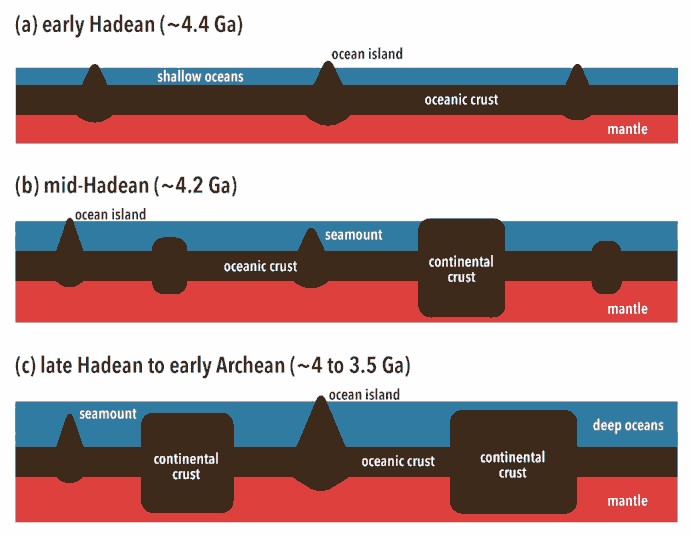
Old-earth geologists tend to base their reconstruction of Hadean history primarily on the hot nebula hypothesis. This is how they believe our solar system formed 4.6 billion years ago. This hypothesis proposes that the planetary bodies, including Earth, resulted from coalescing space rocks and other debris. Interestingly, the 4.6-billion year date does not come from Earth itself, but from dating asteroids they believe formed at the same time the solar system did.1 The Moon yields rocks of this age, and impact craters riddle its surface. This suggests that asteroids and/or comets bombarded it. And if the Moon were under such heavy bombardment, they assume the Earth must have been as well.2
However, recent findings indicate that water covered Earth since virtually the beginning of geologic history. Analyses of zircon crystals dated 4.4 billion years old indicate that they formed at low temperatures in the presence of liquid water.3 This suggests that not only were conditions conducive to the presence of liquid water on Earth’s surface, but that liquid water covered Earth. Some geologists go so far as to argue that a global ocean covered Earth during the early Hadean, with few or no exposed continents.4 Despite high confidence given to reconstructions of the Hadean world as a heavily-bombarded and molten hellscape, there is mounting evidence that it had more in common with Waterworld than Hades!
HADEAN: It’s Hell, Yet There is Life
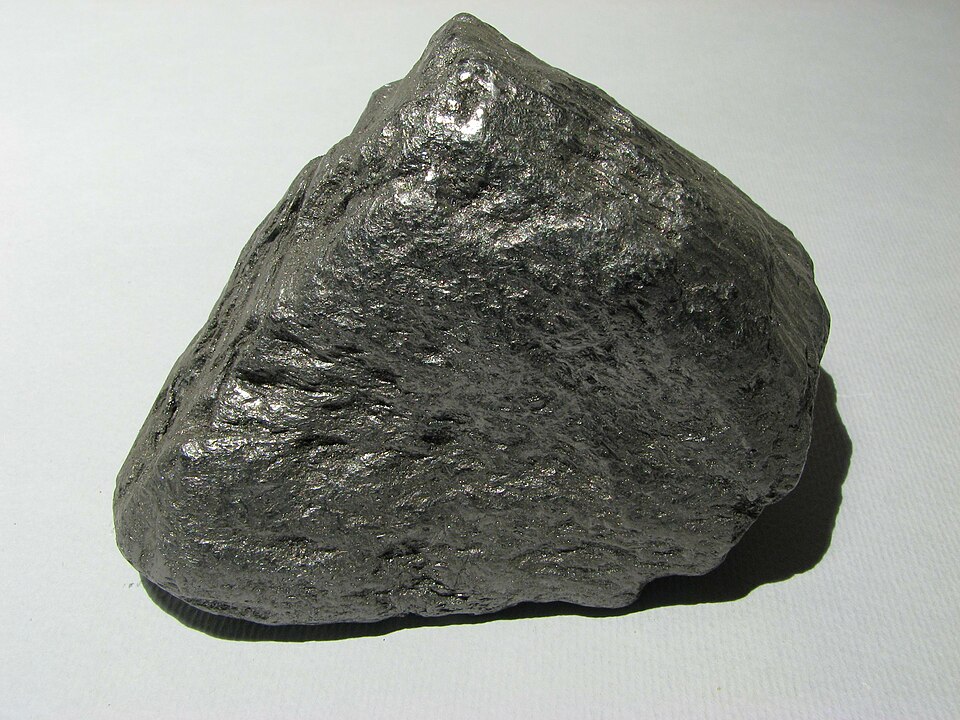
Remember, back in Part 2, when we mentioned the oldest zircon crystals—and oldest known rocks—on Earth? They are located in the Jack Hills of Western Australia. And there’s another secret they reveal to us on closer inspection.
A recent study found that these zircon crystals contained flecks of graphite. Why was this such a game changer? Graphite is a form of pure carbon, one of the main ingredients for life! Carbon can also exist in the form of inorganic molecules, like carbon dioxide. However, the researchers determined that the ratio of carbon isotopes in the graphite is consistent with the isotope ratio found in photosynthetic products. As such, if the graphite is really of biological origin, then this would suggest the presence of life 4.1 billion years ago.5 This gives the already statistically unlikely scenario of life arising from nonliving chemicals an even shorter amount of time to work with. And that old-earth model about the Hadean eon being a molten hellscape? Not as likely once we realize life existed at that time.
Ironically-Fast Iron Formations

Geologists have argued that geologic processes produced the Precambrian over billions of years. Despite this, new discoveries suggest these processes occurred at a much faster rate. For example, researchers once believed Banded Iron Formation (BIF) deposits formed very slowly over millions of years. They believed that each thin, sheet-like layer within the deposit represented the passage of a single year. However, more recent research suggests BIFs formed quickly in deep water by rapid precipitation from volcanic and associated silica-rich and iron-rich hydrothermal fluids.
The chemical make-up, thin layers, and lack of terrestrially-derived contaminants suggest most BIFs formed from chemical sedimentation in the deep ocean.6 When the hot water from the hydrothermal systems vented to the seafloor, they came into contact with the colder seawater. As a result, tiny particles of iron and silica formed. Laboratory studies show that this process happens very quickly, maybe only in a few hours or days. They also show that the rate of the relevant chemical processes increases exponentially with temperature.7 These tiny particles then settle down onto the ocean floor. Other lab experiments have demonstrated these tiny particles can arrange themselves into regular and organized bands.8
ARCHEAN & PROTEROZOIC: Not-So-Super Continents
Scientists often tell us with great confidence that as many as half a dozen supercontinents existed. They came into existence and broke apart well before the formation of Pangaea. Make no mistake, there is much good evidence for the existence of Pangaea, and at least one more supercontinent prior to it.9 But reconstructing this pre-Pangaean supercontinent and what other supercontinents may or may not have come before is not as open and shut as our old-earth counterparts would have us believe. On the contrary, we can be fairly confident in our reconstructions of Pangaea.
How Do We Reconstruct Ancient Continents?
Among other reasons, we can observe the directions the continents move today. They also fit together like puzzle pieces, more or less (e.g. South America and Africa interlock when brought together). We can also support the existence of one single supercontinent prior to Pangaea, which we shall call “Fred.”10 For our evidence of Fred’s existence, we must rely on clues from rocks on our current continents for its reconstruction. The rocks we will use are the Appalachian Mountains and the Caledonian Mountains of Scandinavia.
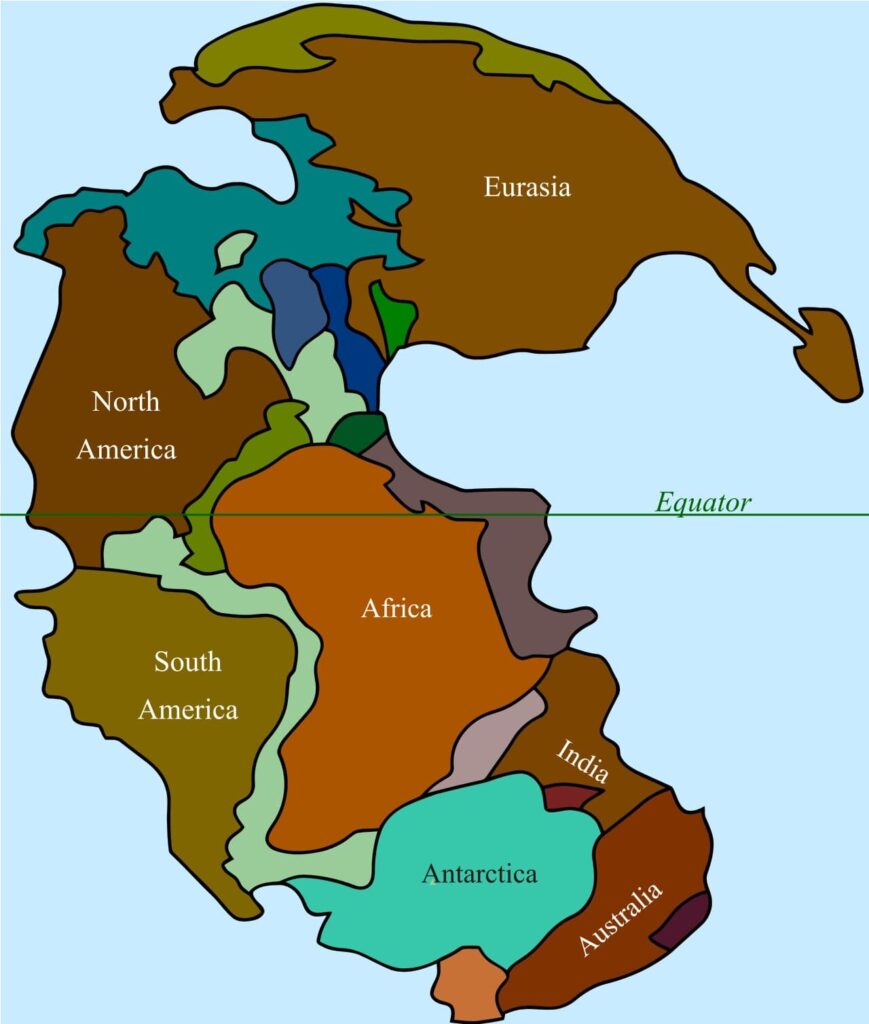
In virtual reconstructions, we can see that these two mountain ranges link together. They once formed a single mountain range. Dubbed the Central Pangaean Mountains by geologists, this single mountain range originally formed at Pangaea’s creation. However, we know there were no Central Pangaean Mountains when Fred existed. They are made of fossil-rich layers of rock. The only way this mountain chain could have formed is after Fred broke apart. These broken pieces, now moving continents covered in layers containing dead animals, crashed together, forming the Central Pangaean Mountains. Later, as Pangaea broke apart, the continental pieces took chunks of the mountain chain with them.
Perspectives on Precambrian Supercontinents
Unfortunately, the recyclic nature of the plate tectonics processes, makes evidence for any previous supercontinents before Pangaea and Fred harder to come by. They are, therefore, more hypothetical in nature. The farther back into geologic history we go, the less concrete evidence exists. As a result, more geologists disagree on continental configuration.
At least one geologist, J.D.A. Piper, has argued that Rodinia and other pre-Pangean supercontinents did not exist. Instead, a single supercontinent was in existence during the entire duration of the Precambrian he calls “Paleopangaea.” He suggests the continental crust was essentially intact from the Archean until after the Neoproterozoic when it broke apart.11 Similarly, geologist M. V. Mints proposes the growth of a single supercontinent during the same period of time. Mints suggests it resulted from high temperature events accompanied by heat and pressure in the Earth’s crust.12 While other geologists have criticized these models, it does illuminate one fact. The reconstructions of pre-Pangean supercontinents are about as set in place as the continents themselves. (Now you know why we called it “Fred”!)
The Uncomfortable Unconformity
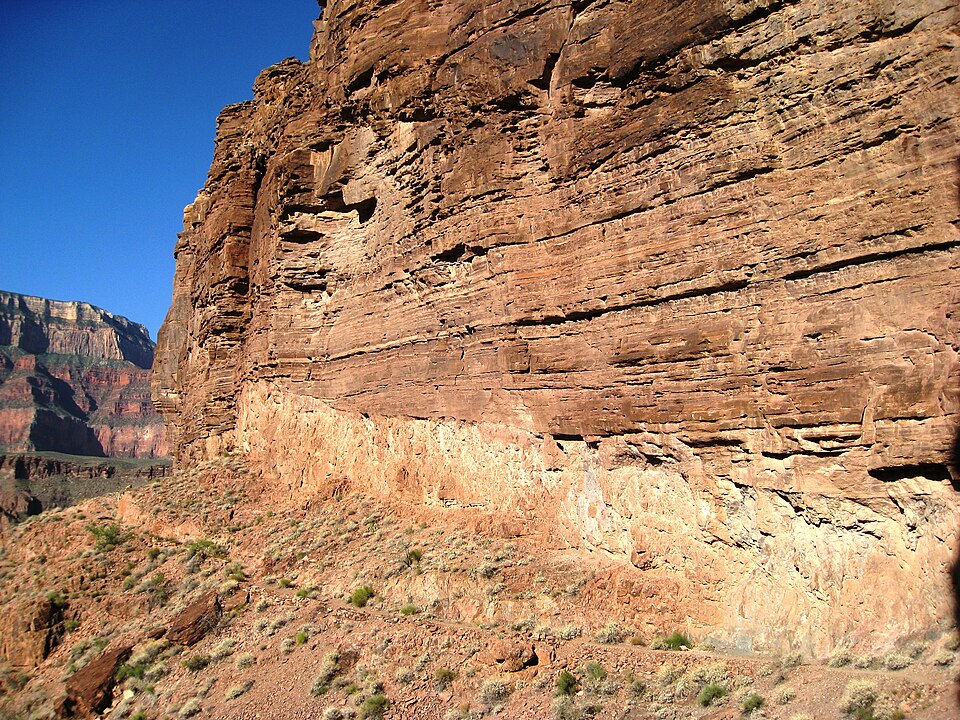
The Great Unconformity―that contact between the uppermost Precambrian from the Sauk Sequence above―has proven to be a great unsolved mystery for geologists. The basis for this difficulty? The contact represented by the Great Unconformity often stands in for a time gap of 1.2 billion years! Old-earth geologists believe that during this time, the earth’s surface experienced extensive erosion until only a beveled surface remained.
Currently, scientists have proposed several competing hypotheses. One suggestion is that the glaciers of the Snowball Earth we mentioned in part three ground the earth’s land surfaces flat as they slowly moved across the landscape.13 Other geologists reject this idea because, according to their research, the Snowball Earth Ice Age occurred before the forming of the Great Unconformity. Another hypothesis suggests that several relatively small and sporadic movements of the earth’s crust during the breakup of Rodinia gradually caused sediment and rocks to wash away into the sea.14,15
Geologists have brought several ideas to the table over the years. However, they all suffer from a lack of evidence for the 1.2 billion years of time supposed to have elapsed. At the very least, such a long timespan should produce a very uneven topography with great river valleys and small hills.
Let’s put this into perspective. Old-earth geologists think that much of the Grand Canyon formed within just five or six million years. The Great Unconformity represents a time gap of more than one billion years. Despite this, very little of the topography that we could expect from that length of time has been produced.
The Ice Age Cometh…Or Slushball Earth
By now, it is perhaps unsurprising that a number of old-earth geologists are not onboard with the Snowball Earth hypothesis.16 Critics of this idea commonly point out that researchers have found fossils of algae, sponges, stromatolites, and a diverse array of microbes in layers attributed to the timeframe of Snowball Earth.17 Could these lifeforms survive in a world completely covered in thick mountains of ice? Many scientists view this as unlikely.
Just as devastating to the Snowball Earth hypothesis are that the sedimentary deposits associated with this alleged ice age are those that form in open water and warm weather conditions.18, 19 Recently, researchers discovered light-reactant macroalgae preserved in black shale that they associate with diamictites of the Nantuo Formation of South China.20 An examination of these deposits suggest that open-ocean conditions habitable for life were much more extensive during these “global ice ages” than once thought. Apparently, they even occurred at least as far north as the mid-latitudes, far from the Equator. Also, they have found deposits of rock attributed to this ice age that were broken up by stormy sea conditions.21 Geologists have even found giant wave ripples in these ‘ice age’ deposits.22 These lines of evidence seem inconsistent with the idea that planet Earth was completely frozen over.
Cool Volcanoes

There is an additional problem with using volcanic-induced global warming to end Snowball Earth. In addition to carbon dioxide, volcanoes also produce copious amounts of ash and aerosols. In the atmosphere, these would block much of the Sun’s heat and light, cooling the planet even more. People observed this during the 1815 eruption of Tambora in Indonesia. This one event generated the infamous Year Without a Summer. During June and July, locals reported snow and frost in both New England and Northern Europe.23
Many geologists feel these lines of evidence leave the Snowball Earth hypothesis out in the cold. They have instead adopted another idea: the Slushball Earth hypothesis. These scientists suggest that while ice covered large portions of the planet, many regions remained ice free.24 But then, how does this account for evidence of glaciers in regions that existed around the Equator at the time? Could we explain this evidence in another way?
Explosions of Life
When it comes to the abrupt appearances of lifeforms in the fossil record, the Cambrian Explosion seems to get all of the limelight. But the Cambrian Explosion is not the only one, or even necessarily the first. The sudden appearance of Ediacaran life forms, after almost four billion years of virtually nothing but single-celled life, has been called the Avalon Explosion. Much like the Cambrian Explosion, the Avalon Explosion features the abrupt appearance of diverse body plans. Both of these explosions were characterized by the abrupt appearance of many lifeforms with body plans distinct from each other, but each containing very few species.25
Exploding Evolutionary Expectations
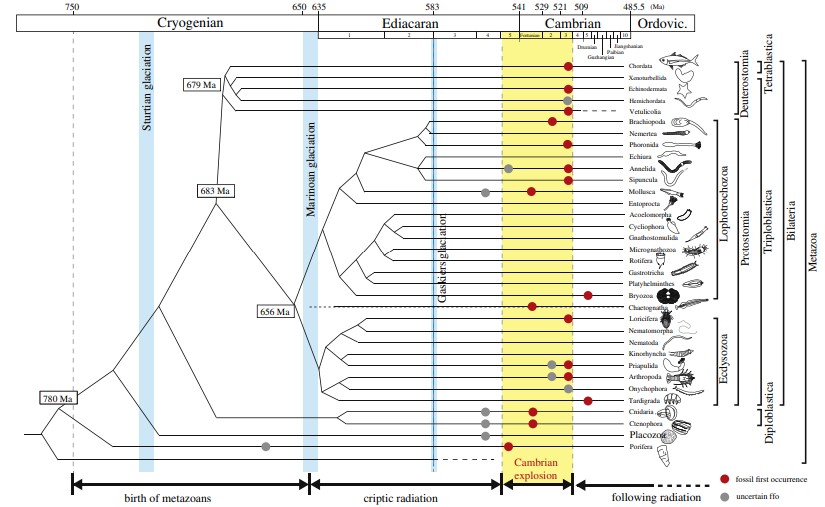
From an evolutionary perspective, we should expect the oldest fossils to show evidence of a handful of lineages diverging from a common ancestor, starting at the species level. Then, with the passage of time, the differences between species should become more pronounced. The handful of lineages should become more distinct as genera (plural of genus) develop, followed by the development of even more distinct families, orders, and so on. The differences between groups of animals should progressively increase as adaptations are attained or lost overtime.
The Avalon and Cambrian Explosions pose a problem because they contradict this expected pattern of evolutionary development from a common ancestor. Scientists as far back as Charles Darwin puzzled over this. The major divisions of animal life, called phyla (plural of phylum), did not show any fossil evidence that they descended from a common ancestor with each other. To explain this, Darwin proposed that fossils of as-of-yet undiscovered organisms would make this explosion of life less apparent.26
Alas, the discovery of Ediacaran fauna has not resolved this issue. These creatures are already distinct with complex body parts. Multicellular life is already quite diverse below the Cambrian. It existed in major groups that were already quite distinct from each other. Some paleontologists have labeled their lack of divergence from a common ancestor a “cryptic radiation.”27
Christianity and an Old Earth
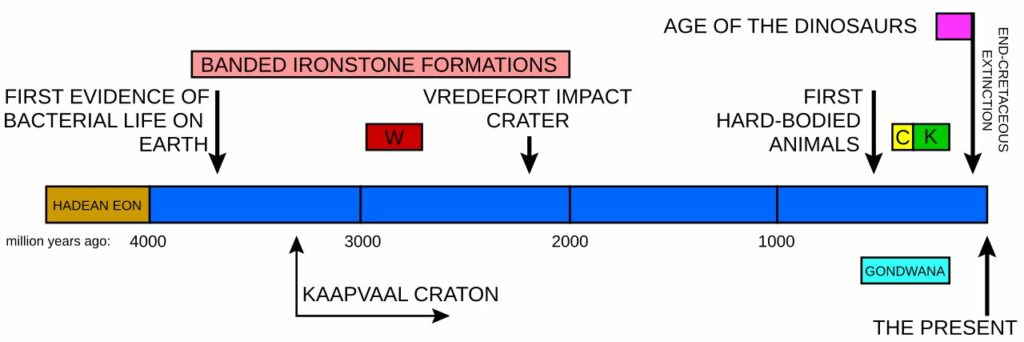
Particularly relevant here for Christians is the vast amounts of time between the creation of the earth and the creation of man in the conventional Precambrian model. The Bible is clear that the first humans were Adam and Eve (Genesis 3:20 & 1 Corinthians 15:45) and that God created them five regular days after the beginning of the universe (Genesis 1:1-31). In addition, Jesus referred to their origin as happening at the ‘beginning of creation’ (Mark 10:6).
But according to the old earth geology model, the universe formed at least 14 billion years before man entered the scene. The earth, meanwhile, is thought to have formed around 4.5 billion years. The first primitive humans did not appear until about two million years ago. To put this into perspective, let us pretend that your shoulder represents Earth’s birthday, and time moves forward down the rest of your arm. The Precambrian eon starts at the beginning of time, aka your shoulder and does not end until your knuckles. The dinosaurs would show up about midway down your fingers. Humanity does not appear until the tips of your fingernails. Humans do not appear until billions of years after the creation of the earth according to this worldview.
What Implications Does an Old-Earth Have for the Bible?
If the old earth timescale is correct, then Jesus was clearly wrong about when humans arrived on the scene (something some evangelical christians are all too willing to accept, sadly). And if that was the case, what follows are serious questions about the validity of the entire Bible.
For Christians, accepting the conventional Precambrian model does not just mean rejecting the straightforward record of earth’s history recorded by God. It also sets an uncomfortable precedence in the minds of believers. If we’re willing to reject this part of the Biblical record on account of current scientific consensus, what about other parts of the Bible that also conflict with that consensus? Like the virgin birth? Or the resurrection of Christ?
Or maybe Christians need to rethink the validity of the current scientific consensus. Is there another way we can interpret the raw data of the Precambrian and reconstruct its history? This is what we’ll begin exploring in Part V.
Acknowledgements
The author wishes to thank Harry Dickens for his involvement in the research and development of this article.
Pilgrimage Through the Precambrian Series
Precambrian Peculiarities (Part II)
The Story of Ancients (Part III)
The Future of the Precambrian Past (Part VI)
Footnotes
- Snelling, A.A. (2015). “Radioisotope dating of meteorites: V. Isochron ages of groups of meteorites.” Answers Research Journal 8:449-478. ↩︎
- Faulkner, D. R. (2014). “Interpreting Craters in Terms of the Day Four Cratering Hypothesis.” Answers Research Journal, 7, 11–25. ↩︎
- Wilde S.A., Valley J.W., Peck W.H. and Graham C.M. (2001). “Evidence from detrital zircons for the existence of continental crust and oceans on the Earth 4.4 nGyr ago” (PDF). Nature. 409 (6817): 175–8. ↩︎
- Miyazaki, Y., Korenaga, J. 2022. “A wet heterogeneous mantle creates a habitable world in the Hadean.” Nature 603, 86-90. ↩︎
- Bell, Elizabeth A.; Boehnike, Patrick; Harrison, T. Mark; et al. 2015. “Potentially biogenic carbon preserved in a 4.1 billion-year-old zircon.” PNAS. 112 (47): 14518–14521. ↩︎
- Klein, C. (2005). “Some Precambrian banded iron-formations (BIFs) from around the world: Their age, geologic setting, mineralogy, metamorphism, geochemistry, and origins.” American Mineralogist, 90(10), 1473-1499. ↩︎
- Lascelles, D. F. (2013). “Plate tectonics caused the demise of banded iron formations.” Applied Earth Science, 122(4), 230-241. ↩︎
- George, J., & Varghese, G. (2005). “Intermediate colloidal formation and the varying width of periodic precipitation bands in reaction–diffusion systems.” Journal of colloid and interface science, 282(2), 397-402. ↩︎
- Snelling, A. A. 2015. “Noah’s Lost World.” Answers Magazine 9 (2): 80-85. ↩︎
- We have chosen the name ‘Fred’ purely for the sake of clarifying our argument and to avoid confusion with other proposed supercontinents whose names we could use, such as Rodinia. And also to avoid constantly using the phrase “the one pre-Pangean supercontinent we actually have concrete evidence for” when the noun “Fred” does just fine. Our editor insisted. Blame her. ↩︎
- Piper, J.D.A. 2015. “The Precambrian supercontinent Paleopangaea: Two billion years of quasi-integrity and an appraisal of geological evidence.” International Geology Review 57, no. 11-12:1389-1417. ↩︎
- Mints, M. V. (2018). “A Neoarchean–Proterozoic supercontinent (~ 2.8–0.9 Ga): an alternative to the model of supercontinent cycles.” In Doklady Earth Sciences (Vol. 480, pp. 555-558). Pleiades Publishing. ↩︎
- Keller, C.B., Husson, J.M., Mitchell, R.N., Bottke, W.F., Gernon, T.M., Boehnke, P., Bell, E.A., Swanson-Hysell, N.L., and Peters, S.E. 2019. “Neoproterozoic glacial origin of the Great Unconformity.” PNAS 116: 1136–1145. ↩︎
- Flowers, R.M. et al. “Diachronous development of Great Unconformities before Neoproterozoic Snowball Earth.” Proceedings of the National Academy of Sciences. Posted on pnas.com April 27, 2020, accessed May 4, 2020. ↩︎
- B.A. Peak, R.M. Flowers, F.A. Macdonald, J.M. Cottle. “Zircon (U-Th)/He thermochronology reveals pre-Great Unconformity paleotopography in the Grand Canyon region, USA.” Geology 2021. ↩︎
- Kirschvink, J. L. (1992). “Late Proterozoic low-latitude global glaciation: The snowball Earth” (PDF). In Schopf, J. W.; Klein, C. (eds.). The Proterozoic Biosphere: A Multidisciplinary Study. Cambridge University Press. pp. 51–2. ↩︎
- Love; Grosjean, Emmanuelle; Stalvies, Charlotte; Fike, David A.; Grotzinger, John P.; Bradley, Alexander S.; Kelly, Amy E.; Bhatia, Maya; Meredith, William; et al. (2009). “Fossil steroids record the appearance of Demospongiae during the Cryogenian period”(PDF). Nature. 457 (7230): 718–721. ↩︎
- Young, G.M. 2013. “Precambrian supercontinents, glaciations, atmospheric oxygenation, metazoan evolution and an impact that may have changed the second half of Earth history.” Geoscience Frontiers 4:247–261. ↩︎
- Schermerhorn 1974. “Late Precambrian Mixtites: glacial and/or nonglacial?” American Journal of Science 274:673-824. ↩︎
- Song, H., An, Z., Ye, Q., Stüeken, E.E., Li, J., Hu, J., Algeo, T.J., Tian, L., Chu, D., Song, H. and Xiao, S. (2023). “Mid-latitudinal habitable environment for marine eukaryotes during the waning stage of the Marinoan snowball glaciation.” Nature Communications, 14(1), p.1564. ↩︎
- Tucker, M.E. 1992. “The Precambrian-Cambrian boundary: seawater chemistry, ocean circulation and nutrient supply in metazoan evolution, extinction and biomineralization.” J. Geological Society 149:655–668. ↩︎
- Allen, P.A. and Hoffman, P.F. 2005. “Extreme winds and waves in the aftermath of a Neoproterozoic glaciation.” Nature 433:123–127. ↩︎
- Luterbacher, J., & Pfister, C. 2015. “The year without a summer.” Nature Geoscience, 8(4), 246-248. ↩︎
- Lewis, J. P., Weaver, A. J., & Eby, M. 2007. “Snowball versus slushball Earth: Dynamic versus nondynamic sea ice?” Journal of Geophysical Research: Oceans, 112(C11). ↩︎
- Shen, Bing; Dong, Lin; Xiao, Shuhai; Kowalewski, Michał. 2008. “The Avalon Explosion: Evolution of Ediacara Morphospace.” Science. 319 (5859): 81–84. ↩︎
- Darwin, C.R., On the Origin of Species, John Murray, London, pp. 310 and 280, 1859, (1st edition). ↩︎
- Shu, D., Isozaki, Y., Zhang, X., Han, J., & Maruyama, S. 2014. “Birth and early evolution of metazoans.” Gondwana Research, 25(3), 884-895. ↩︎

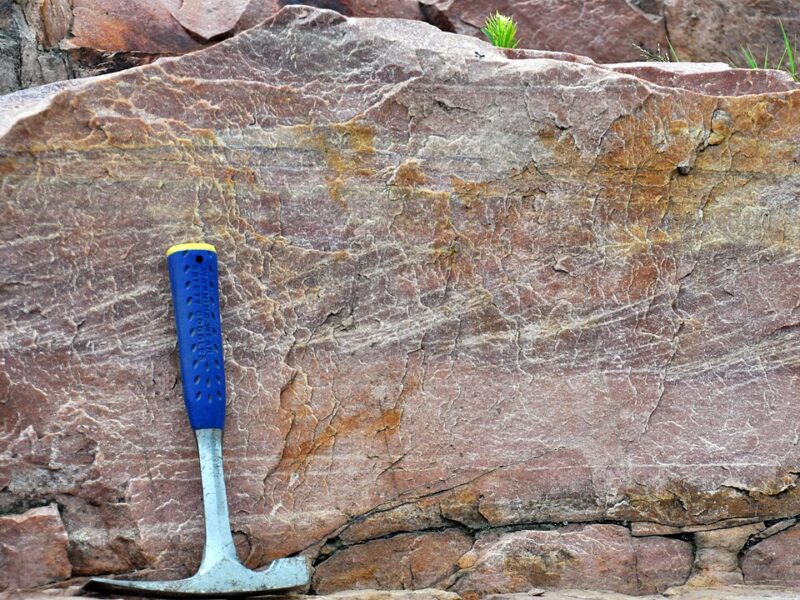
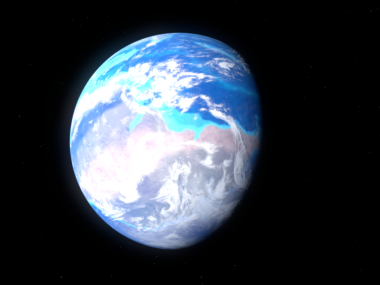

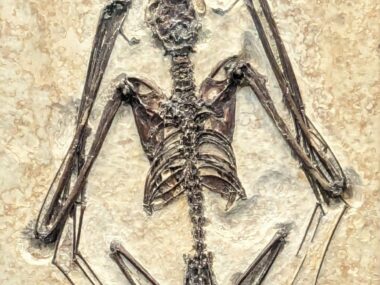



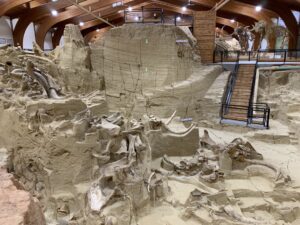



“However, recent findings indicate that water covered the Earth from virtually the beginning of geological history. Analyzes of zircon crystals that are 4.4 billion years old indicate that they formed at low temperatures in the presence of liquid water.”
That’s right, it’s a good prediction of the biblical Genesis. What does it say:
“In the beginning, when God created the heavens and the earth, everything was confused and there was nothing on the earth. Darkness covered the abysses as the spirit of God hovered over the surface of the waters.” (Genesis 1-2)
It’s interesting how modern research reveals facts that are consistent with God’s creation, let’s just drop the dates of billions of years.